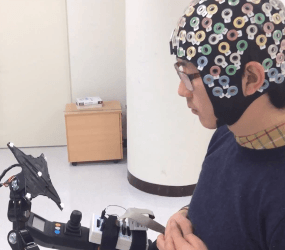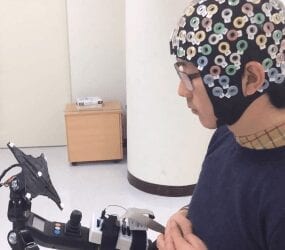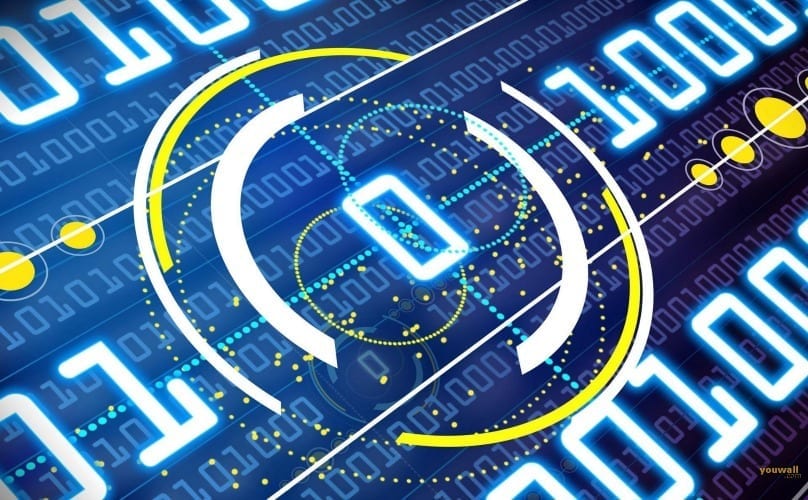
Scientists working at Korea University, Korea, and TU Berlin, Germany have developed a brain-computer control interface for a lower limb exoskeleton by decoding specific signals from within the user’s brain.
Using an electroencephalogram (EEG) cap, the system allows users to move forwards, turn left and right, sit and stand simply by staring at one of five flickering light emitting diodes (LEDs).
The results are published today (Tuesday 18th August) in the Journal of Neural Engineering.
Each of the five LEDs flickers at a different frequency, and when the user focusses their attention on a specific LED this frequency is reflected within the EEG readout. This signal is identified and used to control the exoskeleton.
A key problem has been separating these precise brain signals from those associated with other brain activity, and the highly artificial signals generated by the exoskeleton.
“Exoskeletons create lots of electrical ‘noise’” explains Klaus Muller, an author on the paper. “The EEG signal gets buried under all this noise – but our system is able to separate not only the EEG signal, but the frequency of the flickering LED within this signal.”
Although the paper reports tests on healthy individuals, the system has the potential to aid sick or disabled people.
“People with amyotrophic lateral sclerosis (ALS) [motor neuron disease], or high spinal cord injuries face difficulties communicating or using their limbs” continues Muller. “Decoding what they intend from their brain signals could offer means to communicate and walk again.”
The control system could serve as a technically simple and feasible add-on to other devices, with EEG caps and hardware now emerging on the consumer market.
Read more: A brain-computer interface for controlling an exoskeleton
The Latest on: Brain-computer interface for controlling an exoskeleton
[google_news title=”” keyword=”Brain-computer interface for controlling an exoskeleton” num_posts=”10″ blurb_length=”0″ show_thumb=”left”]
via Google News
The Latest on: Brain-computer interface for controlling an exoskeleton
- China Has a Controversial Plan for Brain-Computer Interfaceson April 30, 2024 at 12:12 pm
China's brain-computer interface technology is catching up to the US. But it envisions a very different use case: cognitive enhancement.
- Tether Acquires Stake in Brain-Computer-Interface Firm Blackrock Neurotechon April 30, 2024 at 5:42 am
Tether, which claims to be one of the largest companies in the digital asset industry, announced that it has made a strategic investment.
- Brain-computer interface research reaches new frontierson April 18, 2024 at 5:00 pm
The applications go beyond controlling devices for gaming however, as the team is also working on a wheelchair that users can drive using this brain-computer interface. Advances in BCI technology ...
- New brain-computer interface lets users game with their mindson April 14, 2024 at 9:00 am
Every brain is unique, just like a fingerprint. Traditional brain-computer interfaces require extensive calibration for each individual user. This involves a lengthy process of mapping brain activity ...
- Brain-Computer Interface Enables Mind-Control Gamingon April 2, 2024 at 4:59 pm
A new study by researchers at The University of Texas at Austin demonstrates a one-size-fits-all noninvasive brain-computer interface (BCI ... neurophysiological control features of an expert ...
- Universal brain-computer interface lets people play games with just their thoughtson March 31, 2024 at 5:00 pm
Engineers have created a brain ... computer interface. At the South by Southwest Conference and Festivals this month, the researchers showed off another potential use of the technology ...
- Brain-Computer Interfaceon March 16, 2022 at 10:56 pm
We noticed you're using an ad blocker. We get it: you like to have control of your own internet experience. But advertising revenue helps support our journalism. To read our full stories ...
via Bing News











